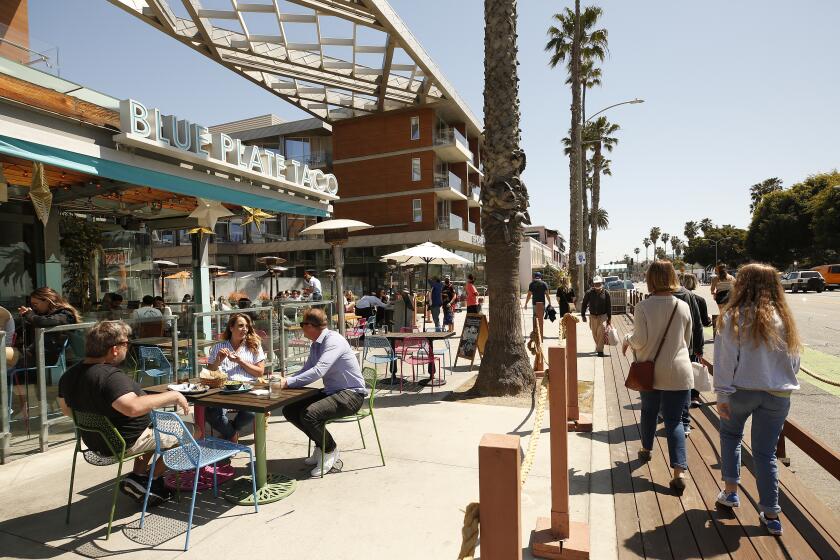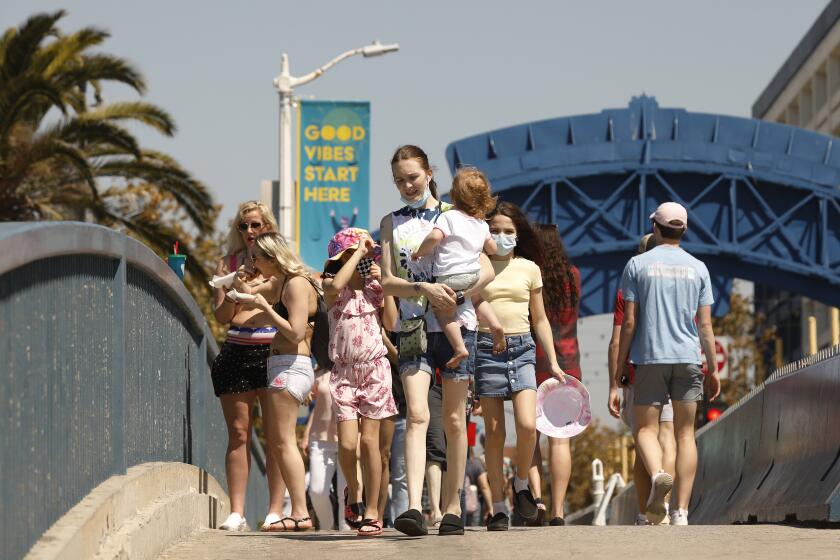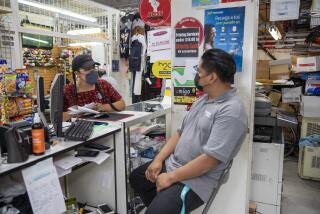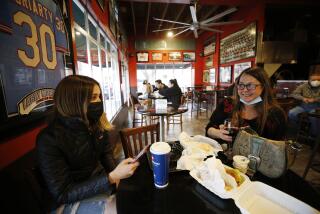California is dramatically reopening despite warnings of a spring COVID-19 wave. How big is the risk?

- Share via
In Washington on Monday, top federal health authorities issued grave warnings that COVID-19 cases are on the rise, and that a national spring surge could be emerging as the coming Easter holiday brings the potential for greater spread.
The next day in California, officials announced that two of the state’s most populous counties — Orange and Los Angeles — were cleared to more significantly reopen businesses and other public spaces as soon as this week, bringing hope of a greater economic recovery for sectors hard hit by a year of pandemic closures.
California so far has seen no signs of the increases that have raised alarms elsewhere in the country.
But it was hard not to miss the seeming contradiction of the two messages — particularly as the director of the U.S. Centers for Disease Control and Prevention expressed a feeling of “impending doom” this week about the pandemic’s nationwide trajectory.
With the move into the orange tier, a whole host of L.A. and Orange County venues including restaurants, bars, retail stores, museums and houses of worship can increase their operations.
Yet officials say they still remain worried that the state could see its hard-won progress compromised if people drop their guard and don’t follow proper COVID-19 protocols.
Public health experts say these are not necessarily mixed messages: Unlike some other states, California still has a number of pandemic-related rules in place, such as a mask mandate. Even as the state eases restrictions, its rules remain more stringent than in many other parts of the country.
What does L.A., O.C. reaching the orange tier mean for reopenings?
Businesses also are still largely required to modify their operations, such as by reducing capacity, stepping up cleaning and disinfection protocols and reconfiguring seating/queueing areas to ensure physical distancing.
Dr. Robert Kim-Farley, a medical epidemiologist and infectious-diseases expert at the UCLA Fielding School of Public Health, said the state’s incremental approach to reopening has worked in its favor.
“If we look at the nation as a whole, we are obviously not going to be avoiding a fourth surge,” Kim-Farley said. “However, in California we are much better positioned, and we are still on a downward trend. If we can all play our part, we can continue on that downward trend.”
The tiered approach, which empowers counties like Los Angeles to adjust their reopening guidelines as needed, is prudent, Kim-Farley said. It also means counties can dial back if things don’t go as expected.
“I think we are being appropriately cautious, and other states are being overly optimistic if they think they can relax all of these restrictions and somehow still see cases dropping,” he said. “That’s not going to be the case. They are going to see increases where they have too rapidly reopened up.”
Paula Cannon, a professor of molecular microbiology and immunology at the Keck School of Medicine at USC, agreed.
“Not only is it based on good science,” she said, “it’s also we have built in this sort of safety net that, if the numbers do start to pick up, we will move back.”
Even with the move to the orange tier, some officials are stressing caution.
While Orange County’s reopenings will go into effect Wednesday, L.A. County Public Health Director Barbara Ferrer said the county would wait until 12:01 a.m. on April 5 to implement the changes, giving officials more time to make sure the last local round of reopenings — which began March 15 — have not increased coronavirus transmission.
“There is a good reason for us to remain in a tier for three weeks before accelerating into a less restrictive tier, because we need this third week to make sure that we’re not seeing an increase in cases,” she said during a briefing. “Remember, this still is a virus that has a very long incubation period, so this week becomes critical.”
With some other areas of the country already seeing an alarming coronavirus rebound, officials say the next few weeks are pivotal if California is to stave off yet another surge.
Ferrer said Tuesday that she couldn’t “say with any degree of certainty what exactly is going to happen here over the next couple of weeks,” but said the amount of travelers who have come to the region recently is a concern.
“Every time we’ve had a lot of travelers here in L.A. County, we’ve had problems,” she said during a briefing Tuesday. “So, we don’t even have to look at what’s going on on the East Coast, we can just look at what went on here over Thanksgiving and the winter holidays to know we have problems when lots of people are traveling.”
But, with more and more people being vaccinated each day, Ferrer said many residents — particularly those most at risk from COVID-19 — have layers of defense they didn’t before.
“Even if we saw this increase in cases that we’re seeing in other parts of the country, because we’ve had a good number of people vaccinated in the highest-risk groups, hopefully that does offer us some protection against ever getting back to a situation where we’ve overwhelmed our healthcare system, which would be something we have to avoid at all costs,” she said.
The latest round of progress means 17 of California’s 58 counties, which are home to roughly half the state’s residents, will be in the orange tier by the start of next week. At the beginning of March, only two sparsely populated counties had made it that far.
While local health officials can opt to keep stricter rules in place, if they think doing so is warranted, reaching the orange tier allows a wider resumption of business activity than many counties have seen in months. Bars can reopen outdoors with some modifications, for instance, and will no longer be required to also serve food.
Capacity restrictions can also be lifted in stores, although social distancing and other pandemic safety modifications still apply; houses of worship, museums, zoos and aquariums can raise their indoor capacity from 25% to 50%; restaurants and movie theaters can raise indoor capacity from 25% or 100 people (whichever is fewer) to 50% capacity or 200 people; and indoor gyms and yoga studios can increase from 10% to 25%.
Bowling alleys can reopen with modifications at 25% capacity. Card rooms and satellite wagering sites can also reopen indoors at 25% capacity. Offices in nonessential industries can also reopen, though the state says workers should still be encouraged to work remotely.
Starting Thursday, amusement parks can also reopen at up to 25% capacity in the orange tier. Effective that same day, California is also allowing limited fan attendance for outdoor sports and live performances, with the cap set at 33% capacity for counties in the orange tier.
Despite the myriad advancements, some public health experts said another COVID-19 surge isn’t only likely — it’s already underway.
“It’s happening right now,” said Dr. George Rutherford, an epidemiologist and infectious-disease expert at UC San Francisco. “There are surges in Michigan, in and around New York, up and down in the mid-Atlantic states. It’s concerning. These aren’t small fluctuations ... these are real trends.”
Adding to that concern is travel linked to the current holiday season, including spring break, Easter and Passover, which could potentially “disperse a new wave of COVID” when people return to their homes, Rutherford said.
Yet there is evidence that the West Coast is faring relatively well, at least for now. The variant of the virus that is most dominant in California, B.1.427/B.1.429, seems to be susceptible to immunization and is less transmissible and less associated with severe disease than the U.K. strain, B.1.1.7, taking hold in other parts of the country, Rutherford said.
“Given the amounts of vaccination that have gone on, and the level of naturally acquired immunity in Los Angeles and the immediate surrounding areas, I think the chances of epidemic transmission are relatively low,” he said, noting that reducing restrictions is the “logical next step.”
“It’s a chance, but it’s always going to be a chance,” he said of the reopenings.
California’s tiered reopening system categorizes counties based on on three criteria: coronavirus case rates, adjusted based on the number of tests performed; the rate of positive test results; and a health-equity metric intended to ensure that the positive test rate in poorer communities is not significantly higher than the county’s overall figure.
More to Read
Sign up for Essential California
The most important California stories and recommendations in your inbox every morning.
You may occasionally receive promotional content from the Los Angeles Times.














